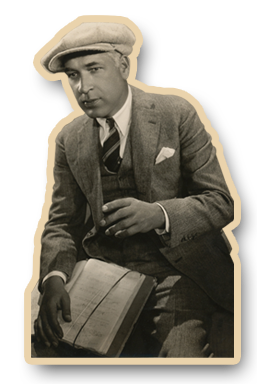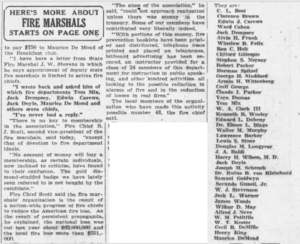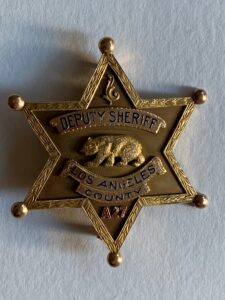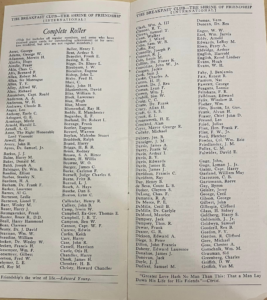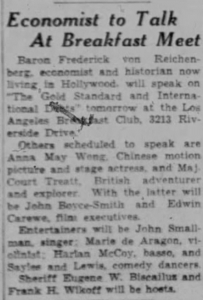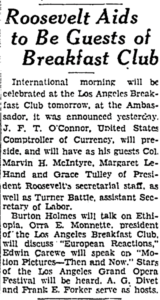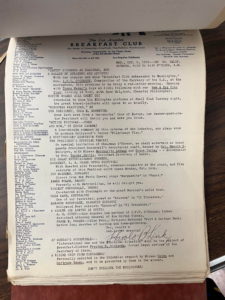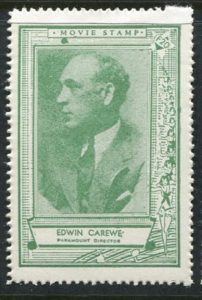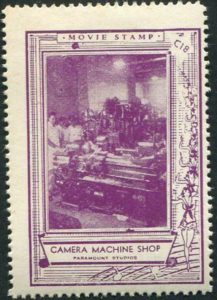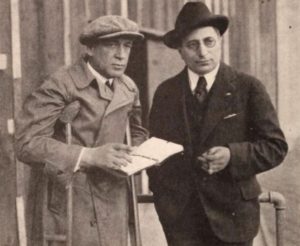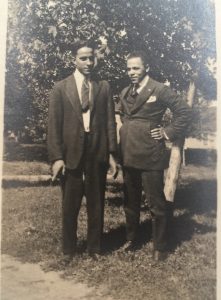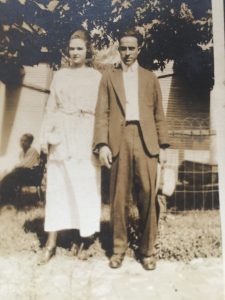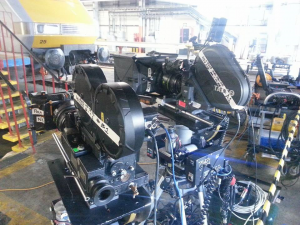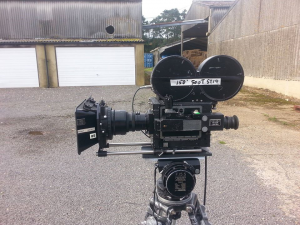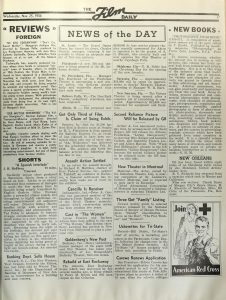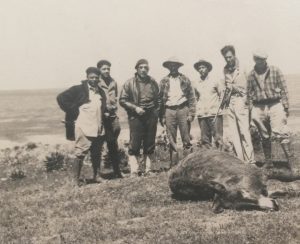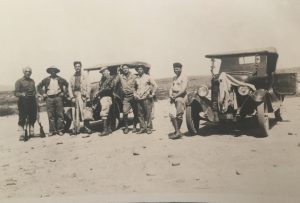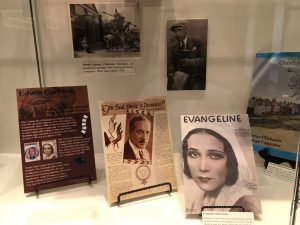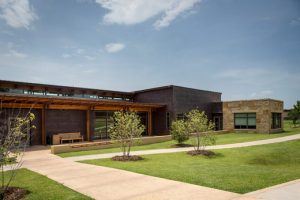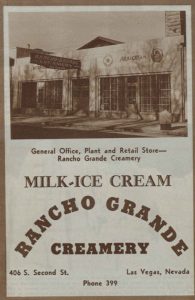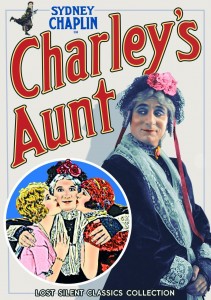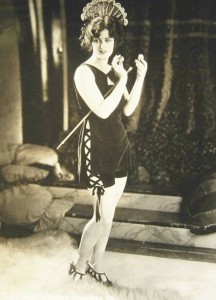The Diamond Studded Badge Brigade
During our recent quest to discover information about Edwin’s involvement with the Los Angeles Breakfast Club, we came upon a story within the story. In a news article from Wednesday, March 30, 1927, Los Angeles Breakfast Club founder, Maurice DeMond, hatched up a plan to sell a more exclusive level of membership with a diamond studded gold card for $750 each. In today’s dollars, that would be around $3000. Inclusive of the price for the card comes a placard for your car which reads, “Deputy State Fire Marshall.” Some members received an actual siren used by the fire departments and a Deputy Sheriff badge. All this, to thwart driving laws and speed through “traffic” in Los Angeles in the 1920’s. Imagine using this scheme today.
Edwin’s name appears prominently in various news articles about “The Brigade.” It is also a rare notation to see his name printed with the letter J. in reference to his original birth name Jay John Fox. From one of the articles, Edwin is noted alongside Heavyweight Boxing Champion, Jack Dempsey, as members of the posse.
The Sheriff’s badge given to Edwin, was issued by Sheriff W.E. Traeger in 1927. It would appear that quite a scheme was put together by Maurice, Edwin and his pals of the time. The “Badge Brigade” attracted enough attention that California Attorney General, U.S. Webb issued an opinion about the matter and to effectively quash the entire scheme.
The Los Angeles Breakfast Club
The date was May 13, 1927. Edwin was to receive his indoctrination into a most prestigious and elite Hollywood club, The Los Angeles Breakfast Club at 3213 Riverside Drive. We have recently discovered that Edwin was a long-standing member of this elite social club.
Founded in 1925 by Maurice DeMond and a group of Equestrians, the club became a social gathering place by exclusive membership. Each member received a gold name card embossed with a green horseshoe, see sample image. Edwin’s interest in joining the club makes perfect sense considering his deep love for horses and many of his Hollywood pals were members too. Names such as Tom Mix, whom Edwin was very close friends, Cecille B. DeMille, D.W. Grifith, Samuel Goldwyn, Carl Laemmle, Louis B. Mayer, Jack and Sam Warner and Rudolph Valentino just to name a few. You can see Edwin’s name on the 1927 roster image.
In another article dated December 17, 1932, Edwin appears at the club, with fellow film executive John Boyce-Smith during a presentation by British adventurer and explorer Major Chaplin Court Treatt. The article states that Edwin is “with” Major Treatt. This detail raises more questions about the relationship Edwin may have had with Major Treatt who was the mastermind behind the Court Treatt Expedition in 1926 South Africa. Edwin appears again in 1935 as a Presenter at the club alongside aids to then President Roosevelt.
Edwin made at least one film in Africa. “A Son of the Sahara.” When we dig a little deeper into Major Treatt, he was married to Stella Maud Court Treatt, a South African film maker. It is entirely possible that Edwin may have known or collaborated with Stella during his filming in Africa, which could have led to a long relationship with the famous duo.
Regarding Edwin’s gold member card, we have to wonder where it might be today. If anyone has seen this card or might know where it could be, please let us know. We would love to discover its location.
We would like to thank the Historian with The Los Angeles Breakfast Club for reaching out to us with all of this new and exciting information.
10th Anniversary – The Edwin Carewe Legacy Archives
It has been a decade since we launched the Edwin Carewe Legacy Archives website and blog. During this time, there have been many new discoveries. We have enjoyed all of the collaborations with researchers around the globe who have shown an interest in the life, times and work of Edwin Carewe. We thank all who have participated in the creation and management of the website and a special thank you to all the fans who have helped us discover new information about our grandfather, great grandfather and great, great grandfather.
Edwin Carewe and the Big 7
We have recently come into possession of a stamp of Edwin for the archive. This poster stamp was an advertising label, slightly larger than a postage stamp and in this case, created by Paramount Studios as a promotional product. The discovery of a stamp with Edwin listed as “Paramount Director” and using the same photo which is shown in the website gallery, is yet another new discovery.
After further research, it was confirmed that Edwin did work with Paramount Studios on one movie, “The Spoilers” in 1930 starring Gary Cooper. At this time in Edwin’s career, he was working with a powerhouse of people within the Hollywood movie industry. Edwin was already working with all of the big production companies which would eventually spawn “The Big 5” from the Hollywood Golden Era. His involvement with Paramount was one of five from the Big 5 list, Paramount, Fox, RKO Pictures, Warner Bros and MGM.
Since his early years as a Director, Edwin worked with Metro Pictures Company which would later become the first part of the MGM name. Then in 1918 after some 17 movies with Metro, Edwin made his first and only movie with the Goldwyn Productions company headed by Samuel Goldwyn and who would later become the second part of the MGM name.
In 1921 Edwin began a five movie collaboration with Louis B. Mayer and his production company, Louis B. Mayer Productions. With this string of movies, Edwin had completed working with all three original companies which would become MGM Studios in 1924.
After just one movie with Goldwyn, Edwin goes back to Metro for another nine movies but changes productions companies often. He made a few movies with Harold Lockwood and it was common that a production company comes along with the actor or actress. In this case it was Yorke Film Corporation.
In 1919 we have our first record of Edwin using his own production company, Edwin Carewe Productions. This was with a movie called “False Evidence” which was filmed in the Santa Cruz and Felton areas of Northern California.
In 1921, Edwin began a long standing relationship with the production company First National Pictures, which was formed in 1917 by a consortium of movie theaters in direct competition to Adolf Zukor who had founded Paramount. Edwin made some 17 movies in partnership with First National, which would ultimately become Warner Bros in 1928. This checks off the third name on the list of the Big 5.
From 1919 to 1920, Edwin made three movies which were distributed by Pathe Exchange, a subsidiary of the world’s largest film production company, Pathe Company in France. In 1927, Pathe Exchange became American Pathe with a new controlling interest by Joseph P. Kennedy, the philanthropic father to J.F.K. It was through these moves and mergers that RKO Radio Pictures was formed. This checks off the forth name on the list of the Big 5.
This leaves us with Fox Film Corporation. As it turns out, Edwin did work with the founder of Fox Studios, William Fox on one film. The 1922 movie, “Silver Wings” was the only time the two ever worked together. It just so happens that Edwin shared the Director role with another up and coming and future four time Academy winner, Director John Ford. They obviously knew each other well enough to co-Direct this movie together.
There were other important movie studios of the Silent Era which are still in business today. Later in his career, Edwin would work with Universal Studios on two movies, both with the same titles, the 1927 and 1931 “Resurrection.” This was not the first time Edwin would remake a movie that he had made earlier in his career. Universal Studios was founded in 1912 by Carl Laemmle.
In the 1928 movie “Revenge,” Edwin began a three movie partnership with Mary Pickford and her film production company, United Artists. Mary had formed United Artists in 1919 with fellow actors D.W. Griffith, Douglas Fairbanks and Charlie Chaplin. Ultimately, United Artists would become a part of MGM in 1981.
There had been only one other time in Edwin’s long and distinguished Directing career that he had a partnership with Charlie Chaplin. Back in 1921 for the movie “Habit,” both Charlie Chaplin and Louis B. Mayer worked with Edwin on this film with their respective production companies.
With this new discovery of a stamp created of Edwin Carewe by Paramount, this has led to a greater review of his work as a Director and many of the relationships he held with most if not all the big powerhouse names in Hollywood during the Silent Era. Edwin worked with all seven of the big names and which we can justifiably call The Big 7 movie studios of all time. Were there any other Directors of this era who had as much versatility? He was referred to by others at the time as “The Duke.” Was Edwin the First Duke of Hollywood?
Edwin Carewe and Louis B. Mayer on Set
An old photo has surfaced which shows Director Louis B. Mayer and Director Edwin Carewe on location in Truckee, California directing actress Anita Stewart in her latest film, “Playthings of Destiny.” Featured on page 60 of the March 12, 1921 Exhibitors Herald, “Carewe is on crutches after being injured, but this would not affect the film’s schedule.” This collaboration between Edwin and Mayer was their first of five movies together.
Looking back at 1921, Edwin was in a three movie deal with Anita Stewart. This was the first of the three movies. It is important to note this is the year that he met his future wife, Mary Akin, our grandmother. It was at the time when President Warren Harding was about to sign the documents to end World War I. Certainly, it was a dynamic time in the history of Hollywood and Edwin’s growing clout as a Hollywood motion picture Director.
Edwin and Louis B. Mayer worked on some five motion pictures together and while Louis would go on to become a co-founder of the bigger MGM Studios, Edwin clearly held regard for Louis and I suspect the sentiments were shared.
Edwin and Roscoe – True Friends!
As a follow up to an earlier post from last year when it was discovered that Edwin had a close relationship with a gentleman named Roscoe Miller, new photos surfaced from an earlier time period with Edwin, Roscoe and Roscoe’s partner Aloise Wade. These photos were taken in Omaha, Nebraska. The photos clearly show Edwin at a much earlier age which confirms the existence of a long standing friendship between Edwin, Roscoe and the greater family.
According to the story from Naomi, “When Aunt Patsy, who is 95, concentrates on the photos with Edwin and her parents, Aunt Patsy recognizes the trees and the surroundings to be the property of her grandfather, Wesley H. Wade, in Omaha, Nebraska. She also said her grandmother, Bertha Wade, is seen in the background of some of the same photos. Therefore, Aunt Patsy suspects the photos had to be prior to 1922. That means the photos had to be taken sometime around 1920 when Roscoe was 28 years old, Aloise was 21, and Edwin was 37 years old.
Because Omaha is described as “a vibrant entertainment culture …echoing the Harlem Renaissance” in Historical Omaha, Nebraska Newspaper Archives, it is highly suspected that Edwin may have lived there at some point in his life. There were “moving picture show” companies like the Lincoln Theatre making “race films” and casting black people and people of color as performers. Roscoe and Edwin most likely met in Omaha during this thriving period of entertainment with performers like Duke Ellington, Louie Armstrong, and Maceo Pinkard. In fact, Roscoe sang as a Tenor in Maceo Pinkard’s Orchestra according to a newspaper article in the Omaha World Herald dated September 10, 1916. Roscoe was very actively tied to the entertainment industry as well as a “singing waiter” at the Brandeis. Somehow, Roscoe and Edwin’s paths met, and they formed a bond.
Aunt Patsy confirmed that the reason the Miller family ended up living in Los Angeles was because of the famous movie director, screenwriter, producer, Edwin Carewe. Roscoe moved to Los Angeles around 1921 leaving his wife, Aloise, living in Omaha with her father for another year. Eventually joined Roscoe and they had five children. She has fond memories of her childhood with “Mr.
Carewe” visiting and clearly remembers hearing her mother, uncle, and Roscoe say, “What would Carewe say…” quite often.”
This has been a wonderful discovery of an important relationship Edwin shared with Roscoe. A story that was unknown to us until recently. Thank you Naomi for sharing.
Photos courtesy of Naomi Miller McCoy.
1928 Mitchell Blimped Newsreel Camera
It has recently come to our attention that a camera once used by Edwin Carewe has surfaced. This camera, a Mitchell BNC (Blimped Newsreel Camera) with serial number 111, first purchased new in April 1928 as a pair #111 and #112 by Edwin and his production company, First National Pictures. This camera is still being used today in the U.K. and abroad.
The current owner “Justin” has stated that, “I’ve owned it for about 12 years and before that it was used on the VFX unit of various films.”
He further goes on to state, “In the enclosed Photographs the camera is doing commercials for British Railways and Cadbury’s chocolate. The other picture is a commercial in Los Angeles. It has also done jobs for Amtrack (American railways) and for SNCF (French Railways).
Justin became curious as to the nature of its origin and contacted the Mitchell Archives and they were able to determine that the original owner was Edwin Carewe.
Here is a fascinating YouTube video of the history of the Mitchell camera.
At the time, the newly developed Mitchell cameras were considered state-of-the-art. They are often referred to as “The Most Influential Camera Ever Made.” The fact that Edwin purchased two, new and with low serial numbers is an amazing new fact in his story.
Thanks Justin for the contact and information, a piece of Edwin and his history remains with you.
Photos courtesy of Justin P. in the U.K.
Edwin Carewe – Educational Movie Maker?
While sorting through our archives in preparation for adding new material to the site, we found a small article from “The Film Daily,” a daily movie and film publication, published on November 25, 1936. It is a very small article. We can find no other page or reference for the remainder of the article unless this was the end and the period was left out.
It says that Edwin was planning yet another business venture by creating educational movies that would be used in schools and within the education system. He apparently also planned to do this in Palo Alto. How and why, we wonder. Was there a tie in to Stanford University?
This was at a time in his life and career when things were winding down on a commercial level, since his last film, “Are We Civilized,” which was released in 1934, just two years earlier.
Edwin’s ranching venture in 1932 in Las Vegas was also a bust, four years before this new venture in Palo Alto. He declared bankruptcy in August of 1933, so perhaps he was looking for other avenues to continue his film career.
Roscoe Conklin Miller – Chauffeur, Confidante & Friend!
It was recently discovered that Edwin enjoyed a close relationship with a man named Roscoe Miller. From his granddaughter, comes a story and connection not previously known. According to Naomi Miller McCoy, her grandfather Roscoe was Edwin’s chauffeur and site manager for Edwin’s production company, First National Pictures, during the years 1924 to 1934. Naomi also shared that her grandfather had also played small parts is several of Edwin’s films.
Naomi states that “Roscoe was in vaudeville shows in Omaha, Nebraska, and he worked at the Brandeis Theatre. He had parts in what were called “race films” at the time. My understanding is that he moved to Los Angeles to work in the movie industry.”
In these photos you can see Edwin and Roscoe with several others. It appears they are hunting. Sorry to the mule! Naomi believes these photos were taken somewhere in Nebraska which could mean that Roscoe and Edwin met before Roscoe migrated to Los Angeles. In one of the photos, the tall white man holding a gun looks like he could be an actor from Hollywood. I wonder if he could be identified.
Edwin and Roscoe both shared a love for the performing arts and both were of mixed heritage. They obviously shared a close bond and it is possible that the two met while Roscoe was working the stage in Nebraska. We would love to learn more about their relationship and if any new information is discovered, we will be sure to post an update here.
Photos courtesy of Naomi Miller McCoy.
Collaboration with the Chickasaw Cultural Center!
We are pleased to announce a collaboration with the Chickasaw Cultural Center at the Holisso Building in Sulphur, Oklahoma. Currently on display and running through mid-September, a new exhibit is on display featuring Edwin Carewe as part of the “Chickasaw Creativity in Film and Performing Arts. If anyone is interested or in the area of Sulphur, Oklahoma, please stop by to preview the exhibit. We would like to thank Emily Santhanam, Curator of Exhibitions and Education, at the Chickasaw Cultural Center for your interest and collaboration. Here are a few photos from the exhibit.
Edwin Carewe – The Rancher!
It was during the year in 1930 when Edwin began scouting a location for his new venture. He had heard about this big ranch in Nevada which would be ideal for the culmination of his business plan to get into the ranching business as his film career was beginning to wind down with the advent of talking pictures.
On January 1, 1931 Edwin signed a lease agreement for more than 150 acres of roaming ranch acreage in Nevada at what would later become Las Vegas. At the time, the ranch and homestead was called “The Stewart Ranch” after Archibald Stewart obtained the land from Octavius Gass, a miner who originally settled on the land from the remains of an old Mormon mission and fort from around 1873.
Helen J Stewart, wife of Archibald and nick named “The First Lady of Las Vegas” owned nearly 3000 acres of ranch land in the 1880’s, in the middle of nowhere. Her family ranch was the only thing here. It was called the “Stewart Ranch.” There was a natural spring near their ranch to supply the much needed water. Her family would sometimes host weary travelers who were making their way down the Old Spanish Trail, or Mormon Trail, between Salt Lake City and southern California. Then there were rumors of the railroad coming to Las Vegas as they were equally interested in finding a resting place where there was water, and to refuel their steam powered engines. Stewart was able to sell a large portion of her ranch to the man who was hoping to bring, and did eventually bring, the railroad through Las Vegas. After she sold the ranch to the railroad in 1902 it was then usually referred to as the “Old Ranch” or “Las Vegas Ranch”, though a few locals still called it the “Stewart Ranch”. The railroad was called the San Pedro, Los Angeles and Salt Lake City Railroad at that time. In Las Vegas they created a smaller company called the Las Vegas Land and Water Co to run local operations here. The LVLWCo leased out the Old Ranch to private residents who could continue to run it as a ranch, dairy and meat market to supply the city’s new residents with these necessary supplies. The railroad coming through here and stopping here is what brought people here and what created Las Vegas as a town, a much needed resting point between Salt Lake City and California.
Through his company, Carewe-Moreton Enterprises and The Biltmore Conservation Corp located in the iconic E Clem Wilson Building on the corner of Wilshire Blvd and La Brea, Edwin set out to begin his venture into the ranching, dairy and eventually the garbage reclamation business. It is important to note that the E Clem Wilson building, built in 1929 and where Edwin began this venture in Los Angeles, was at the time an architectural wonder and he was one of its very first tenants. Today, the building is known as The Wilshire/La Brea Building. It was also used as the first Daily Planet location for the first Superman television series.
In December of 1930, Edwin was in full motion with development plans for a $25,000.00 plant on his new ranch to process garbage and manufacture animal feed. Using patented technology called “The Biltmore Process,” he would use a special chemical treatment and steaming process to render the garbage so pure it would be safe for humans. His plans were quite lofty at the time stating that he was developing this technology in Dallas, Texas with 10 steam cookers and was planning to roll it out nationally to Syracuse, New York, Portland, Oregon and Petaluma, California.
By July of 1931, Edwin had planted some 150 acres of alfalfa, corn and other grains and had harvested some 197 tons of grains to feed the livestock on the ranch which included cattle, hogs and poultry. It was clear at the time that this was a business venture for Edwin and he had every intent of making profits from this venture. Inclusive of the cattle and hogs, Edwin also planned to add various types of poultry to include, chickens, turkeys, quail and Hungarian pheasants. He was also adding the business of frogs to the ranch as well noting that he had planted some 50,000 frogs to the acreage and that he had planned to add frog legs to his venture. In fact, it was during one visit to the ranch that Mary Akin commented that she “looked forward to going frog hunting one evening.”
In correspondences between Edwin and the LVLWCo, he was making attempts to extend his lease from five years to 15 years, noting that he would need a longer lease to make his venture the success that he had envisioned. During these correspondences, he had also made requests to make changes to the buildings on the property and also try to convince the LVLWco to build a dam on nearby waters to provide him with more water to grow his crops. At the time, Edwin noted that he wanted to remove certain buildings and renovate the original adobe home so that his son-in-law, LeRoy Mason, could live there and be in charge of the ranch. LeRoy Mason was also an actor who had worked with Edwin on several silent films. LeRoy was married to Rita Carewe, a daughter from his first marriage before he married Mary Akin, his second wife.
It was during a visit to his new ranch, renamed “Rancho Grande” in February of 1931 that while riding one of his horses, he was bucked from the horse and landed in the middle of the creek and was up to his neck in water and mud, commenting that his tailor would have much work to do in order to clean his fine riding clothes. The horse, a fine white steed can be viewed in the Gallery of photos on this website. At the time he also noted that his long standing friendship with Will Rogers and Tom Mix stemmed from before they were all famous while working together on the famous Miller Brothers 101 Ranch near Ponca City, Oklahoma noting that “ranching runs through my veins.” This would have been sometime around the turn of the century when Edwin was roughly 18 years of age. Ironically, the 101 Ranch was founded in 1893 by Colonel George Washington Miller, a veteran of the Confederate Army and was quite famous for developing a Wild West show featuring regional Indians with Buffalo Bill Cody, Pawnee Bill, Tex Ritter, Tom Mix, Will Rogers and Apache Indian Geronimo.
In March of 1931, Edwin had purchased the business interests of The Las Vegas Creamery at 406 South Second Street in Las Vegas by his new venture at Rancho Grande and was renamed The Rancho Grande Creamery in the grand scheme of production from the ranch to his new creamery in Las Vegas.
By December of 1932, shortly after Carol Carewe was born, his third and last child with actress/wife Mary Akin, Edwin had charged his brother Wallace with managing all the work to be done at the homestead and in conjunction with the Ranch Manager, LeRoy Mason.
In August of 1933, everything changed for Edwin when he declared bankruptcy in a Los Angeles court. Likely, this was a culmination of events in his life starting with the federal charges and indictment for tax evasion in April of 1932 as well as the developing Great Depression. His last film, “Are We Civilized” was produced in 1934 and was his first and only attempt to transition from silent films to talking films.
It is clear from this new discovery that Edwin had carefully planned to enter the ranching and garbage reclamation business as a means of continuing his legacy through his long career in the silent film movie business as both an actor and producer/director.
Spotlight: Wallace Fox
Wallace Ware Fox – Biography
Younger brother to Edwin by some 12 years, Wallace was an accomplished Hollywood movie Director, Producer and Writer who was able to make a successful transition from the silent era, as an apprentice under his brother Edwin, to the modern film era. Wallace directed some 84 films between the years 1927 – 1953. Married to Cleo Inez Easton, he and Cleo had two children, a daughter named Francis and Wally Jr., who recently turned 90 in late 2015.
Wallace joined the West Texas Military Academy prior to joining the Navy in 1910. He stayed in the military until 1919 and served in World War I or The Great War.
Wallace was well known for his work in both Westerns and Horror genres. He worked with such notable actors including Bela Lugosi, Lon Chaney, The Bowery Boys and Johnny Mack Brown. Late in his career he also directed several of the Gene Autry shows on television. He preferred to shoot movies over TV due to budgetary restrictions and was well known for bringing projects in under budget.
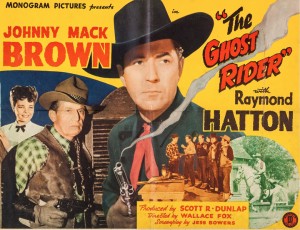

The Chickasaw Times – January 2016
We would like to announce that a write up has been published by the Chickasaw Times which can be viewed following this link:
Spotlight: Mary Akin
Mary acted in some 11 movies roles, several of which were with Edwin and his production company. Beginning in 1924, Mary has an unaccredited role in the silent film, “Picking Peaches,” and received her first credited role in the silent film, “My Son.” In 1925, she appeared in the silent film, “Charley’s Aunt,” starring Sydney Chaplin, the half brother of Charlie Chaplin. This movie can be seen on DVD and is available through any silent film archive or through Amazon.
Follow us on Facebook!
We have set up a Facebook page to add additional exposure for the website but also as a forum to commemorate various film anniversaries throughout the history of Edwin’s life in the film business.
You can follow this link:
